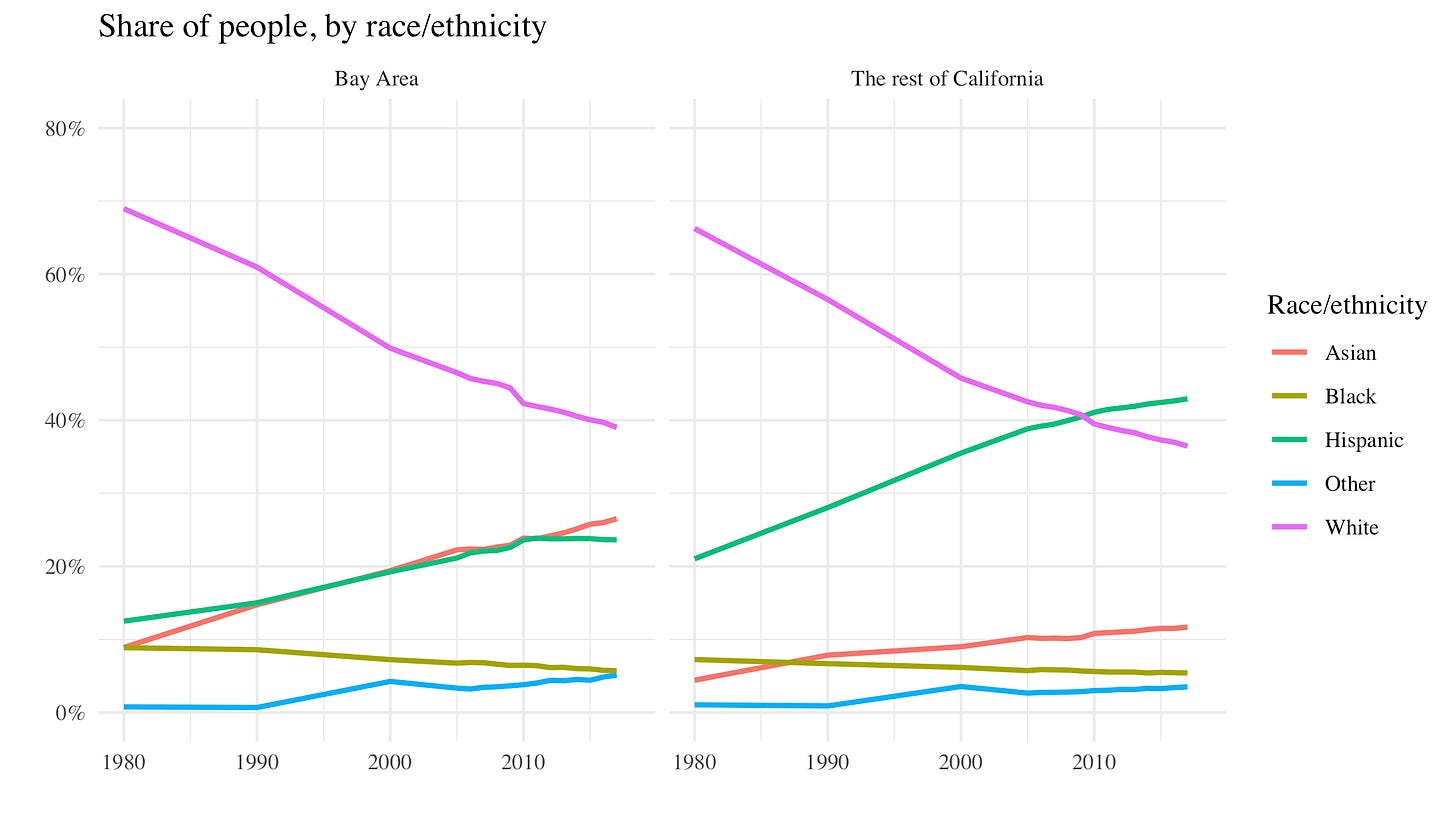The Bay Area is one of the most dynamic, beautiful and tragic places in the world. It is a region with a dazzling history. A center of inequality and opportunity.
Most of why that is cannot be understood through data. Still, data can confirm and challenge preconceived ideas, and provoke new thoughts. I hope this newsletter will do just that. I also hope it helps me become more connected to the place I live, and that it does the same for you.
I intend to send out bi-weekly editions, most of which will be quite short. I will cover a wide range of issues, from the housing crisis to the regional arts scene, among other issues. I am excited to have you with me. Issues will go out every Wednesday morning. You can sign up to receive them here.
For this first newsletter, we are going to discuss demography.
This area is changing fast. I am part of that change. I am a straight white guy in his 30s who makes a living from knowing how to code. My full-time job is as a data journalist for Quartz, though this newsletter is a personal project.
I moved to the Bay Area in 2015 from Minnesota. After living in San Francisco for three years, I left for an apartment in downtown Oakland a little over a year ago. For some readers, my trajectory will feel symbolic for the demographic transformation the region is experiencing.
In reality, while the large migration of tech workers to the Bay Area is a major trend, it is not the only one, and perhaps not even the most important. I analyzed and charted some of key transformations happening in the region.
Over the last three decades, perhaps the most fundamental difference the Bay Area has experienced is that, increasingly, this not a region for the working class. In 1990, only about one third of 25-64 year old adults in the Bay Area had a college degree. In 2017, about half of those people had one. As the chart below shows, the share of those with college degrees is not rising nearly as quickly in the rest of California. This is based on my analysis of US Census data using the “nine counties” definition of the Bay Area. (Note: If you click on any chart in this letter, you can see a larger version.)

Unsurprisingly, the change has been starkest in San Francisco and Santa Clara counties, the homes of the Bay’s tech revolution.

Another major change to the area has been the racial and ethnic make up of its citizens. Like the rest of the US, the Bay is getting less white. It’s just happening a lot faster here. 70% of Bay Area citizens identified as non-Hispanic white in 1990, compared to less than 40% in 2017.
The same is true of California in general, but while the Hispanic population is growing faster in the rest of the state, it is the Asian population that is increasing most quickly in the Bay. The black population is also declining. (Note: “Other” includes Native Americans, who make up about 40,000 of the Bay Area’s residents.)

In each county, the share of non-white residents is quickly falling.
Notably, San Francisco County’s black population has been declining fastest, from about 12% in 1990 to 5% in 2017. For a thoughtful perspective on that change, I recommending watching the recently released movie “The Last Black Man in San Francisco.”

Yet perhaps no change has been more central to the current state of the Bay Area than the aging of its residents. Even more than the rest of the state, the share of people over 65 has jumped since about 2005, while the number of kids is falling off a cliff.

The rise of elderly residents across the Bay Area may be exacerbating the housing crisis. Older residents are more likely to think that the state is affordable, and are less inclined to support new housing in their neighborhood. This is particularly an issue in Santa Clara and San Mateo counties, where housing is needed desperately.

Bay Area media recommendation of the week
Every edition I want to highlight the local journalism I have admired recently. This week, I want to encourage you to listen to the investigation into Vallejo’s police department that was run in KQED’s The Bay. It is deep and important storytelling on police killings in Vallejo, and how it happened. Ericka Cruz Guevarra, the main reporter on the story, deserves a Pulitzer.
(If you read or listened to something great about the Bay Area this week, please send it to me!)
Dan’s favorite things
Each issue I also want to mention one of the activities that I recommend for anyone living in the area.
If you like a good walking tour, do yourself a favor and sign up for the next Berkeley South Asian Radical History Tour. The tour is fun and profound. If you are ignorant as I was, you will be astonished by the long and storied history of South Asian immigrants in the region.
Thanks for your time. See you in a couple weeks.
If you think a friend might enjoy this newsletter, please forward it along. You can follow me at @dkopf
The Golden Stats Warrior logo was made by the great Jared Joiner, who is the most supportive friend a nervous newsletter writer could have. Follow him @jnjoiner


